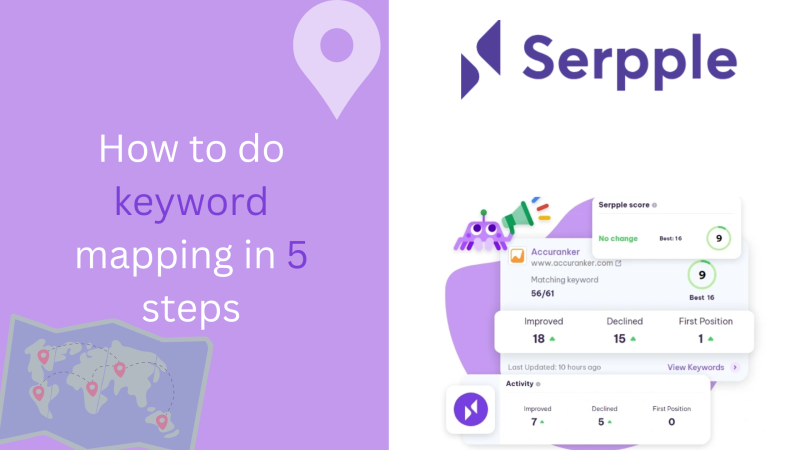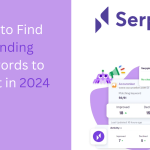You’ve probably heard of SEO keyword mapping, but you’re not sure how those keyword maps even look. Most importantly, where to find target keywords and how to prioritize them?
The good news is that all that can be done using keyword mapping tools is actually much simpler than it looks. In this article, I’ll show you how to create a keyword map, keyword clusters, and bulk-track page rankings.
But first things first. Let’s start by defining keyword mapping and understanding all the benefits it offers.
What is keyword mapping
Keyword mapping is an SEO strategy based on assigning keywords to specific pages on your website, aka the pages where they are most effective.
How to determine which page is the best fit for a particular keyword?
Look for pages that are the best fit for a search intent behind that keyword, those that answer the query and give the most value to the person who is searching for it.
For example, if you have a webshop selling smartphones, here’s how you should group keywords based on the page title:
- Home page: It should contain keywords like “online smartphone shop” and “buy smartphone online”.
- Category page for Apple smartphones: It should contain branded keywords such as “Apple iPhones” and “new iPhones”.
- Product page for iPhone 15 Pro: It should contain precise keywords that show high purchasing intent, such as “buy iPhone 15 Pro” and “iPhone 15 Pro price”.
- Blog posts: Your blog posts should cover the top-of-the-funnel keywords such as “iPhone vs Android” and “Apple or Samsung”
Benefits of keyword mapping
Here is what you can get with this SEO strategy and why keyword mapping is important. It:
- Helps your content rank higher on search engines, so you get better visibility and more organic traffic
- Improves user experience as it leads users to pages that give them exactly what they’re looking for
- Helps you optimize your site structure and architecture
- Provides internal linking opportunities (for more details, check out this guide with proven link-building strategies)
And finally and most importantly: it helps you avoid keyword cannibalization. If Google finds the same keywords on multiple pages it leads to confusion as it’s not sure which page to prioritize in search results which can mess up your keyword rankings.
Click here to find out how to fix keyword cannibalization.
How to do keyword mapping in five steps
It’s possible to do keyword mapping manually, but it’s not the most efficient way. Not only it’s time-consuming but you’d also have to manually update your lists with new keyword data.
Whereas if you use an SEO tool you get to store all data in one place and you’re able to check search volume and keyword difficulty with only one click, helping you decide which keywords to prioritize.
With its daily ranking updates and supreme data accuracy, Serpple may be the best tool to help you find and organize your keywords. It goes beyond ordinary keyword research and suggests low-competition high-impact keywords that can quickly boost your rankings.
What’s more, it’s intuitive and super easy to use, and you’ll be able to create keyword clusters with a few clicks, even though you have never used an SEO tool before. And the best part is that you can use it for free. You can create your account here.
Here’s our quick guide on mapping keywords and creating a keyword map:
1. Setting up your account
Setting up your account is really quick.
- Go to the main menu and select All domains.
- Click on Add domain at the top right corner.
- Add your website URL.
- You can also add your domain shorter nickname, which can be useful if you have multiple domains.
- Choose your region and language.
- Optionally, if you already have some keywords to track you can add them manually or upload a CSV or text file.
1. Find keyword opportunities
- Go to the Keywords Opportunities tool.
- Add your seed keyword as a starting point.
- Choose your region.
- Choose the language.
- Click on Find keywords.
After only a few minutes you’ll get the whole list of keyword opportunities. Compare their search volumes and competition/keyword difficulty to see which ones to prioritize. Ideally, you should look for keywords with a relatively high search volume and low competition as they’re the easiest to rank for.
Also, you may want to check out this guide on how to find low-hanging fruit keywords.
2. Group similar keywords together
The second step is to group keywords based on their semantic similarities, whether they’re direct or indirect synonyms or just keywords that often belong together.
You could do this in a spreadsheet, but in a spreadsheet you can keep just your keywords and not their real-time data such as search volume and keyword difficulty.
With Serpple, you can have all that in one place as we automatically refresh keyword data. Here’s how:
- Go to our Keyword Explorer and find your keyword.
- Click on Add to group.
- Choose an existing keyword group where you want to add your keyword.
- If there are none, create a new group by entering its name.
That’s it!
This approach will help you avoid two most common SEO mistakes:
Optimizing your pages for only one target keyword instead of the whole topic cluster
Adding a bunch of keywords with different search intent to a single landing page which can confuse Google as to how to prioritize keywords.
3. Sort them by search intent and categories
Getting the search intent right is one of the main factors to rank higher on Google.
Now, consider the search intent behind each keyword and group those with the same search intent together—they belong on the same page.
Instead of assigning each keyword individually to a page, it’s much better to assign whole keyword clusters to a page. Not only is this faster, but it’s also more effective.
A keyword cluster is a family of related keywords and phrases that help search engines allow the content and context of your page. Every cluster consists of a primary keyword (the main keyword that you want to rank for and that you’ll put in the page title tag and other prominent places) and secondary or supporting keywords.
When you optimize for a whole cluster of keywords, you’re increasing your chances to rank well for different search queries related to that topic, position your website as a topical authority and make it appear in different Google SERP features.
4. Assign cluster to a page
Now, in your list, you should add links to relevant pages next to each cluster.
With Serpple, you can bulk assign keywords to a page:
- Go to the Keywords section.
- Click on Add keyword.
- Add the URL of your page.
- Choose your region and language.
- And then add keywords related to that page either by typing or you can upload the whole keyword list as a CSV or text file.
What if you don’t have a page that matches some search intent?
Congrats, you’ve found a content gap but that’s a good thing and an opportunity to create new pages. For now, you should assign that keyword cluster to a placeholder URL until you have time to update your content strategy with new content.
5. Track keywords
If you’re not sure what’s keyword tracking and why it’s important, here is a quick recap:
Tracking keywords means monitoring and analyzing your rankings for particular keywords and making sure you outrank your competitors.
You don’t have to do that manually as rank tracking tools can monitor your SEO performance 24/7. Serpple is one of them and check this article out to see why I think it’s the best Rank Tracker alternative.
Not only does it track keywords in real-time and updates its data daily, but it also has one feature that will interest you in this context.
You can track keywords by page!
- Simply go to the Keywords section and scroll down until you see the list.
In the top right menu, choose the option Pages, to organize the list by pages. - For each keyword, you can see its current position on Google.
- You can also see what was its ranking one day, one week and two weeks ago to see how it changed. We’ve also color-coded this, so improved rankings are colored in green and declined rankings are marked in red.
There are other ways to analyze keyword rankings as well. In fact, in our homepage dashboard, you’ll get a quick overview of your SEO performance at any given moment.
Scroll down and you’ll see the lists with keywords whose rankings increased and those whose rankings dropped.
The same goes for their search volumes, so if you notice a significant increase in a search volume for a particular keyword, it might be worth paying extra attention to optimizing its web page.
Also, you can set up email alerts notifications whenever there are any changes in your rankings.
Monitor your competitors by tracking their rankings. Here’s a full guide on how to analyze SERP competitor rankings. With Serpple, you can keep eye on competitors with our Competitor AI feature and get instant alerts whenever they outrank you for one of your shared keywords.
If you’re wondering how much all this would cost, the answer is probably less than you think. It starts at only $19 per month, making it one of the best SEO tools for freelancers, companies, and agencies. We have custom plans for each.
What’s more, you can try it out completely for free, for two weeks which is more than enough to create your website keyword map!
Keyword map example
Here’s what your keyword map should look like. If you don’t want to spend a lot you can create it in tools like Google Sheets or Excel and Google Search Console to find relevant keywords, although it’s much better to use a dedicated SEO tool.
Don’t forget that your keyword map should be regularly updated and that you should stay on track with SEO trends and new keywords that may gain popularity.
Your competitors’ websites are also good place to get some keyword ideas in case you’ve overlooked some.
How to optimize pages with target keywords
You have all these keyword groups and clusters, but what now?
Here are some of the best practices on how to optimize your existing pages with those keywords and improve website rankings.
1. Place your keywords strategically
Even though you have more similar keywords, it should be crystal clear what your primary keyword is. To do that, make sure to include it in the following places:
- H1 tag
- title tag
- meta-description
- some of the H2 tags
For even better results, try to mention the primary keyword somewhere in the first paragraph and of course throughout the content.
If you’re using Serpple, you don’t have to memorize all this. Our on-page SEO checker scans your page to ensure the keywords are added to all the strategic places and will remind you if you’ve missed some of them, as you can see in the picture below.
2. Avoid keyword stuffing
Keyword density used to be one of the main search engine ranking factors but that’s no longer the case. Yet, so many people make the mistake of overstuffing their pages with keywords, thinking it would somehow improve their rankings.
Plot twist: it won’t. It can just ruin the user experience as the content will sound unnatural and repetitive. What’s more, you’re even risking to get penalized by Google.
There’s a fine balance between including all keyword variations and ensuring you mentioned them enough and keyword stuffing. Again, it’s nothing to worry about as our mentioned on-page SEO tool also checks your keyword density based on different factors and suggests whether some keywords need to be added or removed.
3. Use long tail keywords for anchors and ALT tags
I’ve briefly mentioned the importance of an internal linking strategy, but it’s not only about adding links, it’s about how you do it.
Anchor text helps search engine crawlers understand what the linked page is about, so don’t stay away from slightly longer anchors.
For example, if you want to add a link to an article called “Social media tips for Instagram and LinkedIn” go ahead and use that whole phrase as an anchor, if that’s your main keyword. Of course, you can also use secondary keywords as anchors.
On the other hand, people often ask me what to do with those robust long-tail keywords.
My answer: whenever possible, add them to your ALT tags. They’re one of the most overlooked elements of search engine optimization, but they can make a real difference, especially in competitive niches where everything matters.
Conclusion
There you have it! As you can see, keyword mapping for SEO doesn’t have to be difficult but it’s definitely a time-consuming process especially if you’re doing it for the first time.
If you dread the idea of doing all this manually, don’t worry, we’ve got you covered. You can find relevant keywords in Serpple, organize them in groups and clusters and then bulk-track all keyword rankings for one page.
You’ll never miss any change as we send you real-time email notifications so you can act quickly whenever you have to fix something.
Other useful features such as competitor tracking and on-page optimization will help you get the most out of your keyword mapping strategy.
The keyword mapping process is a search engine optimization strategy that consists of grouping keywords with the same search intent together and assigning keyword clusters to relevant pages, instead of assigning single keywords.
Do keyword research and look for keywords that are related or share the same search intent, for example, direct and indirect synonyms. Then look for a page on your website that provides the best answer to that search intent. If there are no existing pages, you should consider creating new ones, as a part of your content and keyword strategy.
A keyword map is a way to organize keywords throughout your website by dividing them into groups that belong together and then assigning them to a particular website page. Creating a keyword map can be done in different ways, but the most practical way is to cluster keywords in a spreadsheet, especially if you have a lot of keywords and pages.
Before you start with keyword mapping, you should do thorough keyword research to discover related keywords and those you may have overlooked. Keyword research tools can help you spot content gaps or keywords and search intents not adequately addressed on your website, while your competitors may have addressed them in-depth. You should adjust your SEO strategy and plan to create new pages covering those topics.
Published by
Adam White
Adam White is a 20+ year SEO professional who has optimized over 400 websites, built and sold over 20 internet and SaaS businesses all with SEO as the main traffic source. Follow him on Twitter/X
All stories by Adam White











